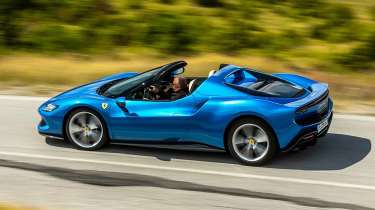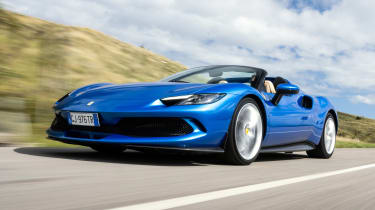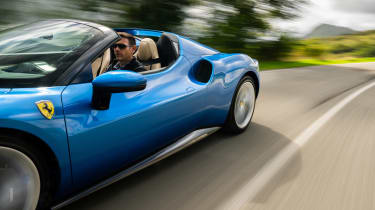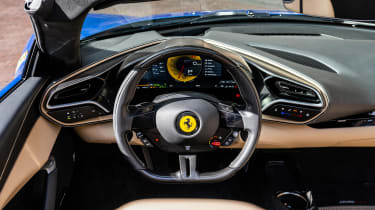Ferrari 296 GTS 2025 review – V6 berlinetta goes roofless to fight the McLaren 750S Spider
Ferrari’s 296 GTS is an 819bhp open-air thrill ride, competing against McLaren's latest and greatest V8 Spider
Like Monday follows Sunday, a convertible version of Ferrari’s mid-engined supercar always follows hot on the heels of the coupe. For many years that drop-top was called ‘Spider’, since the days of the 348 in fact. But just as the 296 has brought with it technical change, so too has the naming strategy been swapped around, with it adopting the GTS designation in convertible form.
Ferrari GTS models have traditionally retained a coupe profile with a pop-out roof panel, as opposed to classic Spiders which chopped the roof entirely in favour of a fabric top. In some ways, then, GTS is an appropriate name for the 296, since it uses a folding metal roof mechanism.
The 296 GTS faces off against the McLaren 750S Spider, and competed with the Lamborghini Huracán Spider before it was discontinued. To a lesser extent, the McLaren Artura Spider and Maserati MC20 Cielo are also alternatives, albeit in a supercar subclass below the 296.
Engine, gearbox and technical highlights
Roof, chassis and weight first. Seventy kilograms. That’s about it, 70kg and some fresh air is about all that separates the new 296 GTS and the 296 GTB. The added weight is due to additional bracing in the chassis and the folding hardtop mechanism.
More reviews
Despite still utilising an aluminium chassis when rivals have all adopted carbon fibre, Ferrari claim the GTS is so structurally rigid that it runs identical spring rates to the coupé and only features minor adjustments to the dampers. As with the coupé, you can have your GTS with the standard electronically adjustable magnetic damper set-up or the fixed-rate Multimatic spool valve system that comes as part of the Assetto Fiorano package.
If the changes seem almost inconsequential it doesn’t lessen the impact of just what a wildly potent car this is. Beautiful, too. And with no roof the evocative, almost sinfully desirable 296 recipe is heightened still further. It’s a compact, pure, almost classically-styled mid-engined supercar with 819bhp thanks to its combination of a 3-litre, twin-turbocharged V6 engine (good for 654bhp and 546lb ft on its own) and electric motor.
The electric hardtop takes just 14secs to raise or lower at speeds of up to 28mph and if you’re in eDrive when you do so, the GTS is quite serene.
Performance and 0-62mph time
The performance is obviously not very classical at all. The 296 GTS will do over 205mph, 0-62mph in 2.9secs and 0-124mph in 7.6secs. That’s three-tenths down on the GTB, but still adequate most of the time. The 8-speed dual-clutch ‘box is brilliantly punchy, too.
The 2992cc twin-turbocharged V6 deserves lots of plaudits. No, it can’t match the screamers of old in terms of aural entertainment, but it’s genuinely characterful, sounds sweet and precise and its power delivery is brilliantly matched to the big hit of electrically-boosted power that’s available from very low revs. When you feel the big punch of torque low down it seems unfathomable that it can be sustained until past 8000rpm.
Yet the GTS confounds expectations and the fury builds and builds. The top end is truly sparkling. You can feel how low down the engine is mounted, too. The GTS really is fantastically lithe and with the roof lowered you even gain a bit of traction as there’s more weight over the rear axle.
With the roof down you do get new noises and new sensations to enjoy. The turbochargers are more vocal, more intrinsic to the car’s appeal and the complex, fascinating sounds of ICE and EV combining is unique and exciting.
Combined with the gentle whoosh of electric motor, the ssssshhhhhhh of fat tyres on tarmac and easy-going but insistent acceleration it’s a very odd thing: A Ferrari that seems to want its driver to enjoy peace, to take in the sights and sounds more than the intensity of the driving experience, a car that encourages you to relax and enjoy the world gently passing by over the curves of those delicious front wings.
Ride and handling
The ride is typical of Ferrari – almost plush in terms of comfort but with a gorgeous sense of control to it. Ferrari has also worked wonders in terms of chassis stiffness. The roofless F8 Tributo feels very compromised compared to, say, a McLaren 720S Spider. It wobbles and creaks where the carbon-tubbed McLaren stays resolute.
However, the 296 GTS gets much closer to the benchmark McLaren and there’s no steering corruption or that horrible feeling that the steering column is made of jelly, either. Does the GTS feels as stiff and precise as the GTB? No… but we’re talking tiny, tiny differences.
It feels much lighter than its 1540kg (dry), the short wheelbase (50mm shorter than the F8 Tributo) gifts the car incredible agility yet there’s no spikiness to the balance even if you snap the throttle closed mid-corner, it feels sensationally fast but also impressively involving. The classical looks hide huge amounts of technology but somehow, Ferrari makes it almost invisible from behind the wheel. It’s intuitive, indulgent and utterly outrageous.
> Ferrari F8 Spider (2019 – 2023) review – Maranello’s answer to the McLaren 720S Spider
The brakes, which have the same ABS Evo system as the GTB, feel more than capable of reigning everything in and due to their effectiveness in terms of trail-braking, and they build confidence as effectively as the strong traction or immediate turn-in. You never feel like the GTS is stretched or running out of composure.
In its heart of hearts the 296 GTS is just like the GTB. It uses its electric power to deliver a 15-mile range and that oddly calm driving experience. But it would much rather you stick the powertrain into Race mode (or even Qualifying, where you get the full 819bhp), twist the manettino past Wet and Sport and go for Race or CT Off and then just get stuck in. And you should, because the GTS is simply a fabulous car to drive with some intent.
Interior
There are some minor issues. The interior looks cool but the functionality of the various haptic switches and pressure pads is complex, overly sensitive and, at times, just annoying.
It also looks a bit like a Christmas tree when fully ablaze in dark conditions, which is at odds with the restrained, elegant exterior. The driving position itself isn’t a patch on the McLaren Artura, either. Or the Maserati MC20 for that matter. You feel on top of the car rather than right down in its chassis.
Price and rivals
Overall, the 296 GTS is deeply desirable and fantastically enjoyable, too. The crazy thing about Ferrari’s entry-level hybrid is just how balanced it is. It’s insanely fast but the raw performance doesn’t dominate everything. Instead the light, precise steering is another highlight and it’s matched really effectively with the poise and sharpness of the chassis.
Despite minor issues with the cabin, the 296 GTS is a fabulous supercar. The engine is a little jewel, the hybrid integration is brilliantly managed and despite embracing too much technology to delve into here, the GTS is remarkably honest in its dynamics.
Even a coupé worshipper could be swayed by this Gran Turismo Spider. It’s just so damn glamorous. However, one thing makes me think the 296 GTB is still the one to get? The price. A 70kg penalty doesn’t seem so bad, but the list price in 2025 is dangerously close to £300k – a premium over the coupe of nearly £40,000.
It’s here the McLaren 750S really does appeal, given the starting price of the Spider is closer to a 296 GTB, let alone a GTS. The McLaren also has the benefit of a carbon tub on its side, limiting a loss of stiffness, the need for structural enhancements and therefore, limiting weight gain. The Lamborghini Temerario Spider is yet to be revealed, but will be a 903bhp open-top alternative to the 296 GTS when it arrives.










